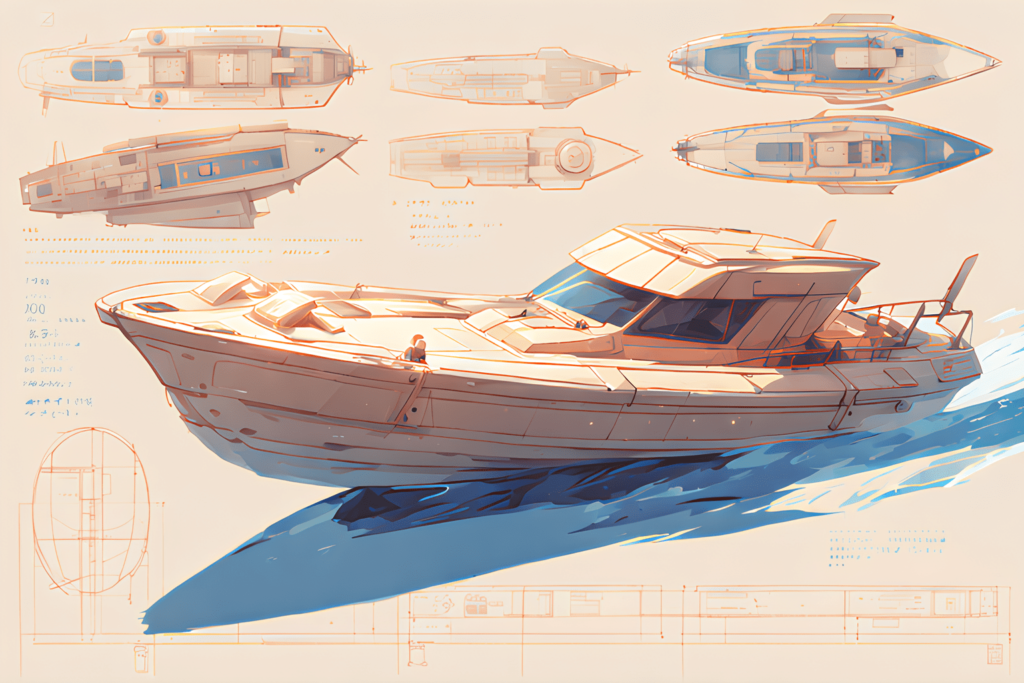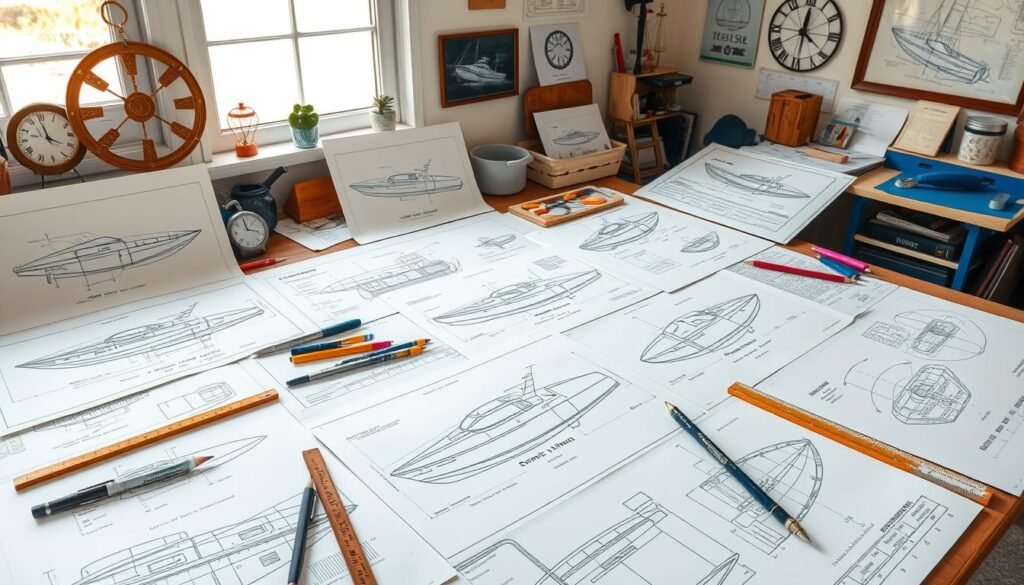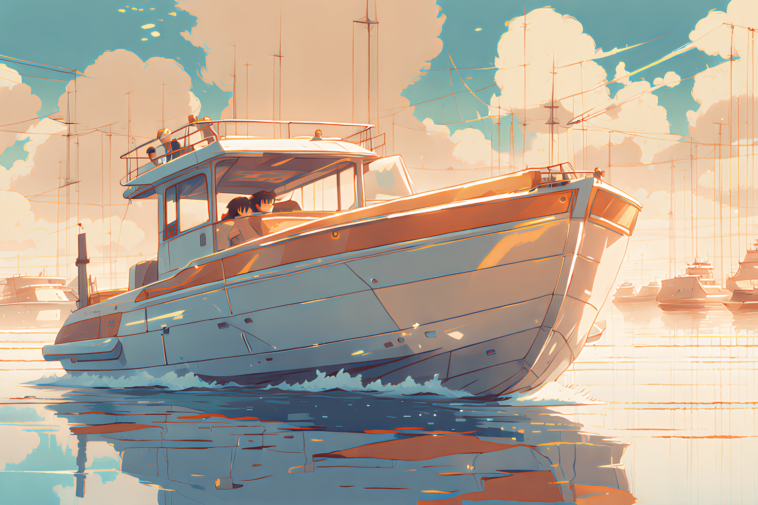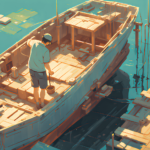Ever dreamed of building your own boat? One that moves through the water with grace and pride? What if making your dream boat was easier than you thought?
Exploring boat building guides opens a world of creativity at sea. Bruce Roberts International, now Fine Line Boat Plans and Designs, has helped DIY fans for over 45 years. They offer detailed wooden boat construction blueprints.
These plans range from small 5.8-meter boats to big 20-meter ones. You can choose from materials like steel, aluminum, and wood epoxy. This lets you turn simple parts into beautiful boats.
Whether you’re a casual builder or a serious sailor, the right plan can make your dream come true. There are designs for every skill level, from the Waverunner to the Spray series. Each plan is designed to help you build your perfect boat.
Key Takeaways – Power Boat Plans & Blueprints
- DIY boat plans range from 5.8 to 20 meters in size
- Multiple construction materials available for custom builds
- Designs suitable for various skill levels
- Over 45 years of professional boat design experience
- Comprehensive blueprints with detailed construction guidance

Introduction to DIY Power Boat Projects
Starting a DIY power boat project is thrilling. It mixes creativity, skill, and the joy of the sea. Whether you’re experienced or new, building your boat is rewarding and practical.
DIY boat building is full of chances for marine fans. With good planning and the right tools, you can make a boat that fits your needs. Plus, you’ll save money compared to buying a boat.
Benefits of Building Your Own Boat
- Significant cost savings compared to commercial boats
- Complete customization of design and features
- Deep personal satisfaction of creating your own vessel
- Improved understanding of marine hardware and boat mechanics
Common Materials Used
Choosing the right materials is key for a good boat project. Marine hardware suppliers have many options for DIY builders:
| Material | Advantages | Cost Estimate |
|---|---|---|
| Marine Plywood | Durable, water-resistant | $80 per 4 sheets |
| Fiberglass | Lightweight, strong | $150-$200 |
| Aluminum | Corrosion-resistant | $200-$300 |
Tools You’ll Need
Having the right tools is important. Outboard motor manuals suggest specific tools for building a boat:
- Power drill
- Saber saw
- Hand belt sander
- Table saw
- Measuring tools
“Building your own boat is not just a project, it’s an adventure that connects you with maritime craftsmanship.” – Boat Building Enthuasiast
With sailboat rigging diagrams and research, you can make your boat-building dream come true. It takes patience, skill, and passion. But the results are amazing.
Understanding Boat Design Basics
Boat design is all about turning materials into vessels that can sail the seas. It’s a mix of art and science. Builders use special tools and equipment to make amazing boats.
Designing a boat is more than just drawing pictures. It’s about understanding how the boat will move on water. Builders pick materials carefully and think about the shape of the hull.
Key Principles of Boat Design
Good boat design follows a few key rules:
- Hull shape and how it performs
- How the weight is spread out
- Choosing materials that last
- Using waterproof sealants and epoxies
“A well-designed boat is a perfect harmony of form and function” – Naval Architecture Expert
Types of Power Boats Explained
Power boats vary in design, each suited for different needs. Knowing about boat trailer designs helps pick the right boat.
- Skiffs: Light, versatile for coastal waters
- Trawlers: Slow, fuel-efficient for long trips
- Performance Boats: Fast, for racing and fun
Choosing a boat design is about finding the right mix of speed, comfort, and purpose. Thinking about the hull, materials, and how it’s built is key to a great boat.
Choosing the Right Blueprint for You
Finding the perfect DIY Power Boat Plans & Blueprints is exciting but also challenging. The right blueprint makes your boat building journey fun and rewarding.

When starting wooden boat construction, knowing what to look for is key to success.
Factors to Consider When Selecting Plans
- Skill level compatibility
- Boat intended use (recreational, fishing, racing)
- Available workspace dimensions
- Budget constraints
- Construction material preferences
Evaluating Boat Building Guides
Not all boat building guides are the same. Experienced builders say look for plans that are:
- Detailed and include construction drawings
- Clear about materials needed
- Have step-by-step instructions
- Specify tools required
Top Sources for Reliable Blueprints
| Source | Unique Features | Plan Availability |
|---|---|---|
| BK Yacht Design | 12 months technical support | HDPE Boat Plans |
| Fine Line Boat Plans | Full-size frame patterns | Multiple boat models |
| Online Boat Design Platforms | Interactive 3D models | Extensive catalog |
“The right boat plan is your blueprint to maritime success.” – Professional Boat Builder
Pro tip: Always check if your chosen boat building guides are detailed and complete. Look for plans with strong technical support and clear instructions.
Unlock the secrets to building your dream boat with MyBoatPlans! With detailed plans for over 518 boats and expert video tutorials, you’ll have everything you need to create your perfect vessel. Click here to begin your journey!
Step-by-Step Guide to Building a Power Boat
Starting a DIY power boat project needs careful planning and precise steps. Whether you’re using fiberglass molds or creating a custom design, knowing the key steps is essential. It turns your boat-building dream into reality.
Preparing Your Workspace
Having a good workspace is key for building a boat. Here are important steps to prepare:
- Choose a clean, well-ventilated area with enough space for assembly
- Get the right tools, like sailboat rigging diagrams and outboard motor manuals
- Use drop cloths or plastic sheeting to protect your work area
- Keep your tools and materials organized for easy access
Following the Blueprint
Being precise is critical when following boat-building plans. Here’s how to do it right:
- Study the blueprint carefully before starting
- Double-check all measurements
- Mark cut lines accurately using the right techniques
- Try out components before attaching them permanently
“Measure twice, cut once” – A golden rule in boat building
Essential Safety Tips
Safety is always the first thing to think about when building a boat. Here are some important tips:
| Safety Aspect | Recommended Practice |
|---|---|
| Personal Protection | Wear safety glasses, dust masks, and protective gloves |
| Tool Handling | Use tools as the manufacturer instructs |
| Workspace Safety | Keep your work area clean and organized to avoid accidents |
Remember, patience and attention to detail are your best tools in creating a safe, seaworthy vessel.
Popular DIY Power Boat Designs
Diving into DIY power boat designs opens a world of exciting possibilities. Whether you’re a seasoned builder or a first-timer, understanding different boat blueprints is key. It helps you create the perfect vessel for your maritime adventures.
Choosing the right boat design is important. You need to think about your skills, the boat’s use, and the marine hardware suppliers. Professional boat builders suggest exploring various designs to find the perfect match for your nautical dreams.
Classic Skiff Plans
Classic skiff designs are popular among DIY boat builders. They are versatile and timeless. These boats typically have:
- Simple, lightweight construction
- Excellent maneuverability
- Adaptability for various water conditions
Modern Center Console Designs
Center console boats offer a modern take on boat trailer designs. They are known for:
- Spacious deck layout
- 360-degree fishing accessibility
- Enhanced storage solutions
Performance Boat Blueprints
For those who love speed and excitement, performance boat blueprints are thrilling. Builders can use specialized boatyard tools and equipment to create high-performance vessels.
| Boat Design | Boats in Service | Construction Type |
|---|---|---|
| Longboat 21-25 | 500+ worldwide | Fiberglass |
| Coastworker 30 | 500+ built | Various materials |
| Atlantic 40 Sport Fisherman | 150+ globally | Mixed construction |
“The right boat design transforms your maritime experience from ordinary to extraordinary.” – Professional Boat Builder
Each design has its own advantages, from classic elegance to modern performance. Your choice depends on your personal preference, skill level, and intended use.
Customizing Your DIY Power Boat
Turning your DIY power boat into a unique vessel is thrilling. With the right guides, you can make it truly yours. It will show off your style and meet your performance needs.
Customizing is more than just looks. It’s about making smart changes that boost both looks and function.
Download over 500 Boat Plans. Click on the link below.
-->Click Here<--
Adding Personal Touches
Personalizing your boat can be creative:
- Custom paint and graphic designs
- Unique interior layout modifications
- Personalized storage solutions
- Custom seating configurations
Upgrading Performance Features
Boosting your boat’s performance can make a big difference. With DIY Power Boat Plans & Blueprints, consider these upgrades:
| Upgrade Type | Cost | Speed Gain | Cost per MPH |
|---|---|---|---|
| Blueprinting | $1,500 | 2-4 mph | $375 |
| Supercharging | $6,799.99 | 10+ mph | $679.99 |
| ECM Reflashing | $595 | 1-2 mph | $297.50 |
When using waterproof sealants and epoxies, apply them right. This keeps your boat strong and fast. Smart changes can turn a basic design into something amazing.
“The beauty of DIY boat building is the ability to create something that is uniquely yours.” – Expert Boat Builder
Plan and do each change carefully. This keeps your boat safe and running well.
Maintenance and Repairs for Power Boats
Keeping your DIY power boat in top shape needs careful attention. Regular maintenance is key for longevity, performance, and safety. Whether it’s a wooden or fiberglass boat, upkeep is essential to protect your investment.
- Inspect hull integrity for damage
- Check sailboat rigging diagrams for wear and tension
- Clean and protect boat surfaces
- Lubricate moving mechanical parts
- Test electrical systems
Routine Maintenance Tips
Effective boat maintenance requires a systematic approach. Create a detailed checklist for different systems and parts. Focus on:
- Exterior hull protection
- Engine and mechanical systems
- Electrical components
- Safety equipment
Troubleshooting Common Issues
Knowing common problems can prevent major damage. Here’s a quick guide for common boat maintenance issues:
| Issue | Potential Cause | Recommended Action |
|---|---|---|
| Hull Damage | Impact or wear | Immediate repair with marine-grade materials |
| Electrical Failures | Moisture or corrosion | Inspect and replace corroded connections |
| Engine Problems | Lack of maintenance | Regular oil changes and system checks |
“Preventive maintenance is always cheaper than reactive repairs” – Marine Engineering Wisdom
Pro tip: Keep a logbook for all maintenance activities. It helps track your boat’s health and spot future issues.
Joining the DIY Boat Building Community
Starting your DIY boat building journey opens up new chances to meet others who love boats. The boat building community is key for those wanting to build their dream boats. It offers the support and advice you need.
Online Forums and Resources
Online platforms have changed how we share and learn about boat building. Some top places include:
- Specialized forums for marine construction
- Websites with detailed outboard motor manuals
- Digital spaces for marine hardware suppliers
- Groups talking about boat trailer designs
“Building a boat is not just about construction—it’s about joining a passionate community of makers and dreamers.” – Experienced Boat Builder
Local Clubs and Meetups
Local boat building clubs offer great chances to meet people and learn by doing. These groups provide:
- Monthly workshops and skill-sharing sessions
- Expert advice from seasoned builders
- Chances to work on projects together
- Sharing of tools and equipment
Getting involved with local and online groups can really boost your boat building skills and confidence.
Conclusion and Next Steps
Building a DIY power boat is an exciting journey into craftsmanship and engineering. With the right plans, even beginners can turn materials into a boat. Start by picking plans that fit your skills and what you want your boat to be.
Having good tools and equipment is key to success. Make sure your workspace is ready, with the right sealants and epoxies. Whether it’s a small boat or a big one, paying attention to details matters.
Turning Your Dream into Reality
Success in boat building comes from planning and learning. Start with simple projects like a 12-foot wooden boat. The MyBoatPlans manual has 518 detailed plans to help you through each step.
Encouragement for First-Time Builders
Every skilled craftsman started as a beginner. Your first boat might not be perfect, but it’s a big achievement. Keep learning, stay patient, and enjoy the process. Your dream of a personal boat is possible.
FAQ – Power Boat Plans & Blueprints
What Are the Benefits of Building My Own Power Boat?
Building your own power boat saves money and lets you customize it. You can pick materials and design features that fit your needs. This can save you thousands compared to buying a pre-made boat.
What Materials Can I Use to Build a DIY Power Boat?
You can use steel, aluminum, fiberglass, or wood epoxy to build a boat. Steel is durable, aluminum is light, fiberglass makes smooth finishes, and wood epoxy combines old-school craftsmanship with modern performance.
Do I Need Special Tools to Build a Power Boat?
You’ll need cutting tools, shaping tools, welding gear, measuring tools, and marine-grade fasteners. The tools you need depend on your material and design. Companies like Bruce Roberts International often suggest tools with their plans.
How Long Does It Take to Build a DIY Power Boat?
Build time varies with boat size, complexity, your skill, and how much time you have. A small skiff might take 200-300 hours, while a big yacht could need 1,500-2,000 hours. Builders usually work part-time and finish in 6-18 months.
What Safety Considerations Are Important in DIY Boat Building?
Safety is key. Follow blueprint specs, use marine-grade materials, and ensure proper hull construction. Understand weight distribution and structural integrity. Always prioritize safety and seek help when needed.
Where Can I Find Reliable Boat Building Plans?
Look for plans from Fine Line Boat Plans, Glen-L Marine Designs, and Boat Design Net. They offer detailed blueprints, instructions, and construction help.
How Much Does It Cost to Build a DIY Power Boat?
Costs vary from $5,000 for a small skiff to $100,000+ for a yacht. Prices depend on materials, size, complexity, and whether you use new or used parts. Plan your budget and add a 15-20% contingency.
Can I Customize My DIY Power Boat Design?
Yes! Most plans let you customize hull shape, cabin, deck, and performance. Designers like Bruce Roberts encourage personalization while keeping safety and integrity in mind.
What Skills Do I Need to Build a Power Boat?
You’ll need basic woodworking, metalworking, welding, and understanding technical drawings. While advanced skills are helpful, many builders start with little experience and learn through patience and community support.
How Do I Join the DIY Boat Building Community?
Join online forums like WoodenBoat.com, Facebook groups, local clubs, and workshops. These communities offer advice, help, and support during your project.



